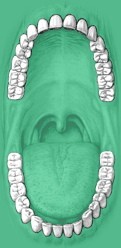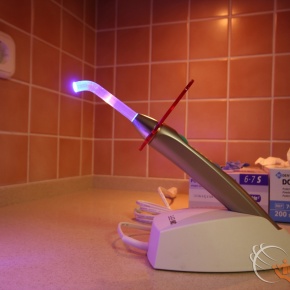Periodontal diseases are infections of the gums and bone that surround and support the teeth. In its early stage, called gingivitis, the gums can become swollen and red, and they may bleed. In its more serious form, called periodontitis, the gums can pull away from the tooth, bone can be lost, and the teeth may loosen or even fall out. Periodontal disease is mostly seen in adults. Periodontal disease and tooth decay are the two biggest threats to dental health.
Causes
Bacteria in the mouth infect tissue surrounding the tooth, causing inflammation around the tooth leading to periodontal disease. When bacteria stay on the teeth long enough, they form a film called plaque, which eventually hardens to tartar, also called calculus. Tartar build-up can spread below the gum line, which makes the teeth harder to clean. Then, only a dental health professional can remove the tartar and stop the periodontal disease process.
Warning signs
The following are warning signs of periodontal disease:
- Bad breath or bad taste that won't go away
- Red or swollen gums
- Tender or bleeding gums
- Painful chewing
- Loose teeth
- Sensitive teeth
- Gums that have pulled away from your teeth
- Any change in the way your teeth fit together when you bite
- Any change in the fit of partial dentures
Risk factors
Certain factors increase the risk for periodontal disease:
- Smoking
- Diabetes
- Poor oral hygiene
- Stress
- Heredity
- Crooked teeth
- Underlying immuno-deficiencies—e.g., AIDS
- Fillings that have become defective
- Taking medications that cause dry mouth
- Bridges that no longer fit properly
- Female hormonal changes, such as with pregnancy or the use of oral contraceptives
Prevention and treatment
Gingivitis can be controlled and treated with good oral hygiene and regular professional cleaning. More severe forms of periodontal disease can also be treated successfully but may require more extensive treatment. Such treatment might include deep cleaning of the tooth root surfaces below the gums, medications prescribed to take by mouth or placed directly under the gums, and sometimes corrective surgery.
To help prevent or control periodontal diseases, it is important to:
- Brush and floss every day to remove the bacteria that cause gum disease.
- See a dentist at least once a year for checkups, or more frequently if you have any of the warning signs or risk factors mentioned above.
The treatment of periodontal disease begins with the removal of sub-gingival calculus and biofilm deposits. A dental hygienist procedure called scaling and root planning is the common first step in addressing periodontal problems, which seeks to remove calculus by mechanically scraping it from tooth surfaces. Dental calculus deposits harbor harmful bacteria. Calculus stuck to teeth appears to be hardened to the point requiring mechanical scraping for removal. The bacteria responsible for most periodontal disease are anaerobic, and oxygenation reduces populations. Thorough brushing with dilute hydrogen peroxide, with emphasis on the gum line, and flossing, helps prevent the formation of harmful biofilm, gingivitis, and tartar. Therapeutic mechanical delivery of hydrogen peroxide to subgingival pockets can be provided by a water pick. Another method for treatment of periodontal disease involves the use of an orally cadministered antibiotic, Periostat (Doxycycline). Periostat has been clinically proven to decrease alveolar bone loss and improve the conditions of periodontal disease with minimal side-effects. However, Periostat does not kill the bacteria, as it only inhibits the body's host response to destroy the tissue.
Laser-assisted periodontal therapy has been shown to kill the bacteria that cause periodontal disease as well as grow bone in certain cases.
Causal treatment
Plaque is a soft white layer which forms on the surface of our teeth and under our gum line, containing large amounts of bacteria. If left unchecked for a few days, it will harden and form tartar. Bacteria and food particles accumulate in the spaces between our gum and teeth, and produce chemicals and toxins that cause inflammation of the gum around the teeth. It is essential to professionally clean the teeth from plaque to prevent periodontal diseases. Plaque and tartar, left untreated for a longer period of time, will be required to be removed using ultrasonic plaque removal methods. These methods are designed to thoroughly clean our teeth under and above the gum line without damaging the gum. Ultrasonic plaque removal not only scrapes away bacterial plaque easily and fast, but also creates a soft surface where bacteria will not be able to accumulate. This soft surface can be kept clean and free from plaque for a long time by regular brushing at home. It is suggested to undergo plaque removal and a thorough dental cleaning every six months.
Regenerative technique
Periodontal regeneration requires the coordinated formation of new alveolar bone, dental cementum, and functionally oriented periodontal ligament interposed between these two tissues. These requirements pose particular issues that are unusual or unique to the periodontal tissues.
These include:
- the requirement for the coordinated formation of the three tissues of the periodontal ligament;
- the potential role of bacterial contamination during healing;
- the specific requirement for dental cementum formation, a tissue that is not seen in other parts of the body;
- the requirement for coronal regeneration of tissues towards the overlying superficial tissues.
Currently, the focus of treatment of severe periodontitis is regenerative in nature. The surgical treatment of periodontal disease has evolved from a discipline characterized by resection as the primary means for pocket elimination to one where regeneration is the primary theme. The concept of periodontal regeneration has also evolved as considerable histologic and other basic scientific knowledge and clinical evidence has been amassed over the last 2 decades, indicating that the regeneration of periodontal tissues lost as a result of periodontitis can be achieved in humans.
As regenerative therapy for periodontal disease has evolved, various treatment modalities have been developed. Bone grafts, root surface demineralization, and guided tissue regeneration have all been used with varying degrees of success to regenerate lost attachment in deep intrabony defects. Histologic observations and controlled clinical trials have demonstrated that some of the available regenerative procedures may result in healing that can be termed periodontal regeneration. Clinically, several factors may affect the extent of clinical attachment gain and bone regrowth as a case outcome.
Of the different clinical obstacles in regenerative therapy, primary soft-tissue closure over the treated area seems to be of paramount importance. A list of other obstacles to be overcome includes behavioural risk factors such as plaque control and smoking; intrinsic risk factors such as general health, diabetes, and genetic predisposition; local risk factors such as pulpal health, root anatomy, osseous defect morphology, and root preparation; selection of the appropriate surgical technique to achieve the intended goals of treatment; and lastly, clinical skill.




